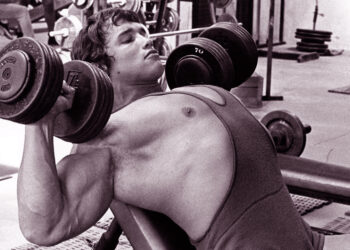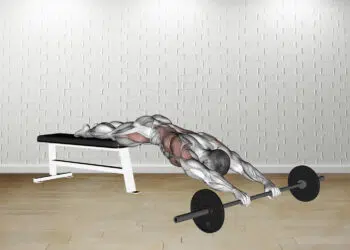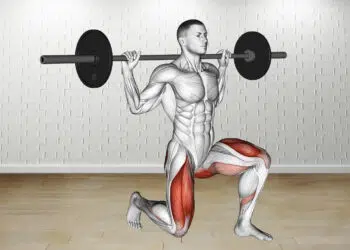The dumbbell step-up may be looked down upon by many because it’s not a squat or deadlift. In other words, it may be thought of as a wimpy exercise because it’s commonly used in aerobics/step classes.
But the opposite is true. The step-up can be an amazing lower body mass and strength builder when done the right way. Plus, your core muscles have to stabilize and balance your body during the movement.
Not to mention, it’s a good choice for those with knee problems as it keeps your shins more vertical, thereby reducing the stress at the knee joint.
And, you can make this exercise harder by increasing the height of the object used to perform step-ups and also by holding weights.
Keep reading to learn how to maximize this exercise and we also offered some tips, effective variations, and some advice for including it in your workouts.
In this Exercise
Level Up Your Fitness: Join our 💪 strong community in Fitness Volt Newsletter. Get daily inspiration, expert-backed workouts, nutrition tips, the latest in strength sports, and the support you need to reach your goals. Subscribe for free!
- Target Muscle Group: Quadriceps, hamstrings, glutes, calves
- Type: Hypertrophy, strength
- Mechanics: Compound
- Equipment: Dumbbells or step
- Difficulty: Beginner
Muscles Worked
The entire lower body is involved when performing the step-up and we’ve provided a short description for each one below.
Quadriceps
As the name suggests, the quadriceps or quads for short is a four-headed muscle consisting of the rectus femoris, vastus lateralis, vastus medialis, and vastus intermedius.
This group of muscles acts on the knee and hip joint and is crucial for walking, standing, and moving around in general.
Hamstrings
The hamstrings are opposite the quads on the back of the upper leg and are comprised of three muscles: semitendinosus, semimembranosus, and biceps femoris.
This muscle group is essential for hip extension, knee flexion, and stabilization of the knee joint. Therefore, the hamstrings are heavily involved in walking, standing, and explosive movements such as running and jumping.
Gluteus maximus
The gluteus maximus is the largest of the glute muscles that make up most of the shape and form of the butt and hips. It’s the main extensor of the hip and externally rotates the thigh.
Adductor magnus
The adductor magnus is the largest of the medial compartment thigh adductor muscles that originate from the pelvis and insert into the femur.
It, along with the other muscles adduct or bring the thigh toward the midline of the body, stabilize the pelvis, and help to maintain the balance of the pelvis during walking.
Gastrocnemius
The gastrocnemius is the larger of the two calf muscles on the back of the lower leg that makes up the bulge from the middle of the leg up to right below the knee.
It has two heads: medial and lateral and is responsible for plantarflexion (point the town down and away from the leg) of the foot and ankle and flexion of the knee.
The gastrocnemius joins with the soleus to form the Achilles tendon at the lower part of the leg. Due to having a predominance of Type II fast-twitch muscle fibers, the gastrocnemius plays an important role in running and jumping or activities that involve fast movement.
Also, because the gastrocnemius crosses the knee joint, it aids in knee flexion, and consequently, standing calf raises are best for maximizing activation of this calf muscle.
Soleus
The soleus muscle is a large, flat muscle that sits deeps to the gastrocnemius and runs down to the lower leg to help form the achilles tendon.
This muscle also functions to plantarflex the foot and ankle. But because the soleus has a predominance of Type I slow-twitch muscle fibers and is, therefore, has a bigger role in supporting standing posture.
Level Up Your Fitness: Join our 💪 strong community in Fitness Volt Newsletter. Get daily inspiration, expert-backed workouts, nutrition tips, the latest in strength sports, and the support you need to reach your goals. Subscribe for free!
Seated calf raises may be better at maximizing activation of the soleus as the gastrocnemius is shortened and sort of at a mechanical disadvantage.
Learn more about how different exercises can be more effective for either calf muscle here.
Core
The core muscles consist of the rectus abdominals or abdominals (six-pack), internal and external obliques (located on either side of the rectus abdominis, transverse abdominis (deep core muscles), and spinal muscles.
The rectus abdominis pulls the pelvis and ribcage in toward each other and is the group of muscles targeted with crunches. Then there are the obliques that rotate and laterally flex the trunk.
Traverse abdominals pull the belly button in toward the spine and also help to stabilize it.
Erector spinae muscles help to stand upright and bend backward and the multifidi fill in the grooves of the vertebrae and stabilizes the spine during movement.
How To Do The Dumbbell Step-Up
Here are step-by-step instructions for this exercise.
- Stand in front of a bench or raised platform while holding a dumbbell in each hand (optional) and maintain a good posture.
- Step up onto the bench with your left leg and drive through your foot to stand all the way up. Try to keep your shins as vertical as possible so that your toes do not move far forward and past your knees.
- Bring your right foot up as well so you’re standing with both feet on the bench.
- Now step down off the bench with your left leg, and bring your right leg down so both feet are on the floor.
- Repeat by stepping up with your right leg, and then bring your left leg up onto the bench so you’re standing on the bench with both feet.
- Step down off the bench with your right leg, and bring your left leg down so both feet are on the floor in the starting position.
- Repeat by alternating your legs for the desired number of reps.
Here’s a video example…
Dumbbell step-up tips
- You can use a bench, box, chair, or anything similar to perform this exercise.
- Use any training tool to add resistance to this exercise. A barbell, kettlebells, cans, or anything to add more weight can work just as good.
- Control the movement to maintain your balance and ensure that you’re giving equal effort on both sides.
- Avoid using momentum. Try to drive through your feet to activate the lower body as much as possible.
- Try to keep your shins as vertical as possible. One advantage of this exercise over others is that it’s great for preventing excess stress at the knee joint because you can avoid moving the knees too far forward past the feet.
- Keep your back straight and core tight during the movement.
- You can lean forward to engage more of the posterior chain muscles such as the hamstrings and glutes.
- You don’t have to bring the non-working foot up onto the bench. This will challenge your balance even more and allow you to do faster reps.
- The more advanced you become, the faster you can alternate legs.
3 Variations/Alternatives
While step-ups are very effective, here are three variations/alternatives that we recommend.
Step-up jumps
This is a great variation for training lower-body explosiveness and is ideal for athletes or anyone who’s looking to introduce more functional training. You’re basically jumping up and alternating legs which looks something like this…
Lateral step-ups
Improve your lateral lower body development by doing the lateral step-up variation that involves standing sideways to the object. The movement will be a little more challenging than the basic step-up but you’re also training muscles such as the adductors that don’t get as much attention.
Here’s a video example.
Single-leg squat
Whether you do the pistol squat, levitation squat, or any variation of the single-leg squat, you’ll still work the same muscles. Although, these alternatives can be a little more challenging.
How To Incorporate The Dumbbell Step-up Into Your Training Routine
The dumbbell step-up makes for a great standalone lower body exercise but it’s also a great addition to your current leg-building workouts.
Some advantages of the step-up are that it’s not as physically demanding as squats and other compound exercises, and you don’t need much equipment to do it.
In addition, because it’s a unilateral exercise, it has great carryover to athletic movements and the balance and stability required makes it a very functional exercise for everyone.
Related: The 5 Best Unilateral Leg Exercises
With enough resistance, it can still build muscle mass and strength although it shouldn’t necessarily be the only exercise that you do.
The step-up can also be a great alternative to lunges that can be stressful for the knee joints and that’s why we highly recommend including it in a leg workout routine.
Sets/reps
While there’s no one-size-fits-all set/rep scheme for the dumbbell step-up, we do recommend mixing up your sets and reps based on your training goals.
For example, using a lower rep range with heavier weights is best for building strength. Moderate reps and medium to heavy weights is best for building muscle mass and higher reps work for hypertrophy and muscular endurance.
At-Home Leg Workouts For A Stronger Lower Body
Wrapping Up
The dumbbell step-up is one of the best lower body exercises that has several benefits to take advantage of. It’s a viable muscle and strength builder but also one of the best functional movements that you could include in your lower body workout regime.
It also requires minimal equipment and isn’t as physically demanding as heavy squats and deadlifts. Although, you should still do your heavy compound lifts for maximum development.
Interested in measuring your progress? Check out our strength standards for Seated Calf Raise, Deadlift, Hip Extension, and more.








